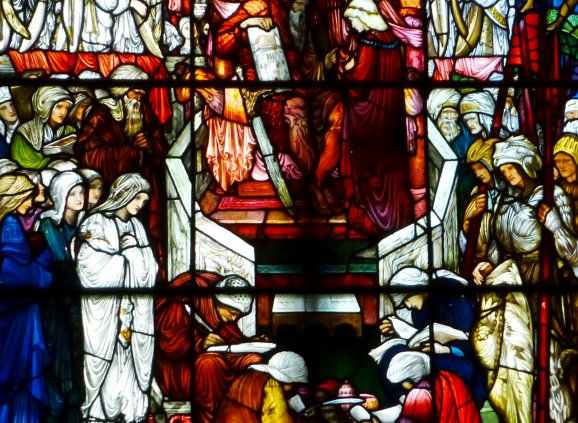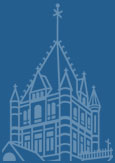
- Trinity Voices
From the Historian: The Dexter Window

From the gallery four harpists peer down as King David delivers his charge to Solomon to complete the temple. It is a small but striking detail of a vibrant stained glass window located in Trinity baptistery. Originally referred to as the Dexter Window, today it is more well-known by the scene depicted in glass, David’s Charge to Solomon. The angelic form of the harpists and other figures is signature Edward Burne-Jones and the exquisite execution of his design is by William Morris & Co.
Resting upon the King’s knees are the plans of the future temple that he knows he will not live to see. Frederic Dexter presented the window to Trinity in memory of his father George Minot Dexter (1802-1872). As explained in an 1888 church description, “the design is considered especially appropriate as Mr. Dexter lived but just long enough to see the plans of the new church completed and the work begun.”
George Minot Dexter was member of a prominent New England family that traced its roots to England and Ireland. It was a family of farmers, merchants, ministers, doctors and politicians. Dexter’s path led him to become an architect and civil engineer. He was actively engaged in his discipline. In 1836, he received the commission to design the houses for Boston’s Pemberton Square and all accompanying ironwork. Today, 1300 of his architectural drawings for 85 different projects can be found at the Boston Athenaeum, a building he would help to create between 1847-1849.
In 1863 Dexter, then senior warden of Trinity Church, called upon a young minister in Philadelphia. Phillips Brooks, the descendant of several New England families of note, was attracting great attention for his presence in the pulpit as he served in a Philadelphia parish. Many parishes across the nation sought his service. Trinity was especially active in its attempt to inspire a call to Massachusetts. It only took six years. In 1869 Brooks became Trinity’s ninth Rector.
The church at that time was located on Summer Street in downtown Boston. Always forward thinking, Brooks discerned that it was time for the church to move to a new location, Boston’s Back Bay, in effect to follow the congregation that was leaving the increasingly commercialized downtown. Land had already been purchased and a Building Committee formed when Boston’s Great Fire of 1872 destroyed the Summer Street church.
Dexter served on the Building Committee that selected the design of architect Henry Hobson Richardson. The building was constructed between 1872-1877 and revolutionized American architecture. Still recognized as one of the most important buildings in the States, the structure remains a vital faith home to our active Episcopal parish. Dexter did not live to see the building’s consecration in February 1877. He died November 26, 1872.
In addition to the sentiments expressed in the stained glass window, Dexter’s service to his church is also recognized on a wall tablet featuring an inscription by fellow parishioner, Honorable Robert C. Winthrop. The North Transept tablet refers to Dexter’s self-sacrificing nature and how he remained “active to the last in good works and particularly in his tender care for the interest of the living and the remains of the dead during the trying scenes which attended the burning of our old house of worship in Summer St …”
Winthrop refers to the fact that beneath the Summer Street church was a crypt with family vaults. That crypt was laid bare by the destruction of the building overhead. Dexter would tend to those remains until he lost his life.
After Dexter’s death, Phillips Brooks confided in a letter: “My kind friend Mr. Dexter is dead. His funeral is to be this morning. I do not know of anything more calamitous that could have befallen the church, and personally I had become very fond of him for his constant kindness and thoughtfulness and the simple, bright, transparent character he always showed. … Mr. Dexter had been very busy since the fire removing the last of the Trinity dead to Mount Auburn. He took a severe cold and last Saturday was laid up, and Tuesday he died of congestion of the lungs. I shall miss his friendship sadly, and to the church his loss is simply irreparable. He was full of interest in the new church, and meant to give now his whole time to it. He had been warden of Trinity about fifty years, and yet was young and fresh and progressive …”
Throughout Trinity Church you’ll notice not only magnificent stained glass windows like David’s Charge to Solomon but also wonderfully decorated tablets with words that provide just a glimpse into the lives of people who called Trinity home.
Sources and Additional Reading
The Garden Square of Boston by Phebe S. Goodman
http://cdm.bostonathenaeum.org/cdm/ref/collection/p15482coll1/id/839
- December 2022
- November 2022
- June 2022
- February 2022
- January 2022
- October 2021
- September 2021
- August 2021
- July 2021
- June 2021
- May 2021
- April 2021
- March 2021
- February 2021
- January 2021
- December 2020
- November 2020
- October 2020
- September 2020
- August 2020
- July 2020
- June 2020
- May 2020
- April 2020
- March 2020


Comments